 |
|||||||||||||||||||
|
We arrived in Vienna on a warm day in July, 2003. As we approached the city, we found a fellow motorcyclist following us. Stopped at a light, we suggested a stop for something cold to drink. He agreed, then led us into the city and took us to the best ice cream shop in town, Tichy (right), where all the tables were full and the crowd was about 5 people deep to order. So with Roland’s help, we got a wonderful and very different introduction to this beautiful historic city. Vienna owes much of its grandeur to the Habsburgs who settled here in 1278 and made Vienna the capital of the Austrian empire. Most of the historic buildings are in the Innere Stadt, the old portion of the city once surrounded by a moat. The moat has since been filled in and replaced by a ring road allowing access to this historical center. In the heart of the city is the Stephansdom (St. Stephen’s Cathedral), an impressive towering structure and the principal landmark (below right). The roof is covered with 250,000 colorful glazed tiles from Bohemia. The south tower (seen in the photo, completed in 1167) has 347 steps to get you to the top while the north tower was never finished and is not visible from this perspective. Legend has it that while the tower was being built, the wine from that year was particularly sour. Being a miser and not wanting to waste the wine, the emperor ordered the wine to be used in mixing the mortar. So in the city of wine, even the cathedral is made of wine.
The Cathedral is located in the Stephanplatz, just off the Graben (below right), a wide circular pedestrian path around the central part of the city. The Graben used to be the moat around the original town, filled in with rubble created by the destruction of the medieval houses and made into the wide street. Along this street in the 17th century the wealthy built their homes as the city expanded. The result is this lovely expanse of architectural delights from the 18th and later centuries.
Intersecting the Graben at Stephansplatz is the Kamtner Strauss, another pedestrianized walkway through the center of the old city. This street is lined with hotels and shops of every type, as well as cafes, restaurants and of course, ice cream stands. Here as well you will find a few street performers and an occasional beggar. The beggars, however, are silent, have no signs, and simply sit or kneel with their hands held outward and open. They often lower their heads as if in prayer and rarely make eye contact. We were not sure if this is simply a local custom or if local restrictions drive this behavior. Below is the Hofburg or Imperial Palace, located near the center of town. This rambling palace was periodically expanded since the 13th century and walking through it you can see the various periods in the architectural styles. Inside the Hofburg is the Spanish Riding school, the royal apartments, several chapels, the national library (which has 2 cats on the official payroll to keep the mice at bay) and the imperial treasury containing the crown jewels.
Of course, no trip to Vienna would be complete (at least for Verna) without a visit to the famous Sacher Hotel for a taste of the original Sacher Torte (chocolate cake with apricot filling, below left).
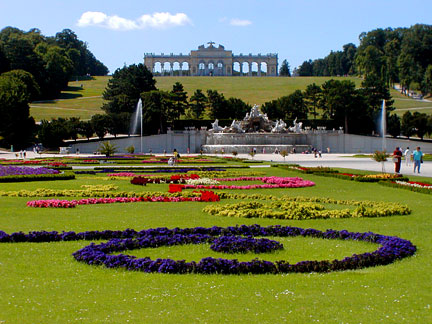 (almost always for political gain, which is how they expanded their empire) and who had the most children (probably Marie Caroline who had 24). In 1762 Mozart gave a concert in the music room for Maria Theresa when he was only 6 years old. (almost always for political gain, which is how they expanded their empire) and who had the most children (probably Marie Caroline who had 24). In 1762 Mozart gave a concert in the music room for Maria Theresa when he was only 6 years old.
In Maria Theresa’s time the palace employed 1500 servants, but later during the rule of Franz Joseph, it was reduced to 1000. The palace was lived in by the Habsburgs until 1918 when the emperor abdicated and fled to Switzerland. The upper floors of the palace are now private apartments which you too can rent at only $1,000-1,500 a month. Of course, there is a short waiting period of 12-15 years. One of the main public rooms is the ballroom, where John F. Kennedy met Nikita Krushof in 1961. The room has a beautiful frescoed ceiling with 3 different themes. The largest central one represents all the Austrian Empire at its height when it ruled from Belgium to Northern Italy, over 55 million people. At one end is the war fresco which was hit by a bomb in W.W.II and had to be restored. Over 200 bombs hit the palace grounds, but only this one hit the palace itself and luckily this bomb never detonated.
S Our stay in Vienna was enjoyable and varied. It is a city full of surprises with a little bit of something for everyone. You could spend an entire week here in the museums and still not get through them all. Or you can wander through the city enjoying the sights and savoring the food and wine. We did a bit of each and had a thoroughly enjoyable time. |
|||||||||||||||||||
|
If you find typographical errors or have any other problems when looking at the site please contact the Webmaster describing the problem and the page involved. |
|||||||||||||||||||
|
Copyright © 2000-2009 Jim Seavey and Verna Norris All Rights Reserved |
|||||||||||||||||||
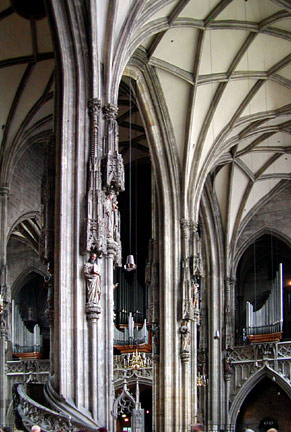
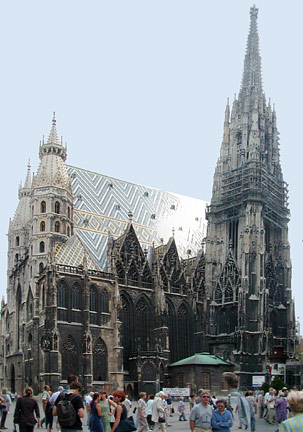
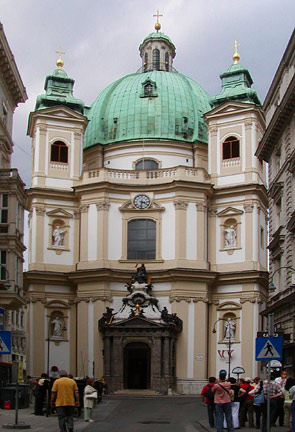

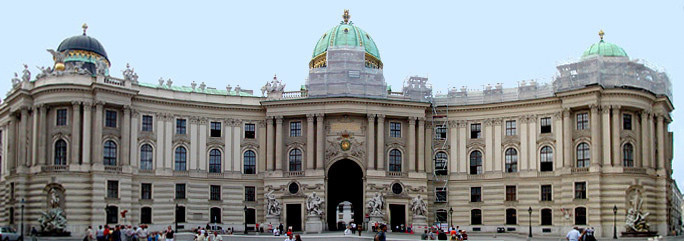
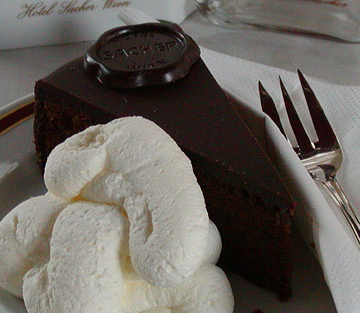
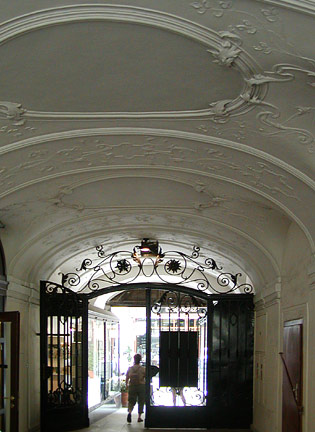

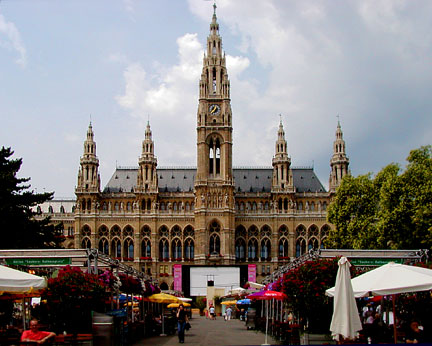 The grounds themselves cover many acres and include a zoo (the first in Europe), a maze, a lovely Gloriette on the hill, fountains, palm houses and formal gardens. Above is a photo of the gardens as viewed from the palace. The building at the top of the hill is the Gloriette where Maria Theresa could enjoy her breakfast.The entire southwest corner of the city center just outside the ring is a mass of gorgeous buildings including museums, the city hall and the university, all interspersed with gardens, squares and statues. If you are a museum-lover, Vienna is the place for you! Not only do they have a rich collection of museums, but the buildings themselves are works of art. In amongst these is the city hall, a huge eye-catching piece of architecture (left). While we were there, they were having an international food-fest in the square in front of the city hall. The structures you see in the photo with the hanging flower baskets are the eating areas. Along the sides many countries were represented from Asia, Europe, the Americas and Australia. We enjoyed the Vietnamese and Chinese with the Austrian beer.
The grounds themselves cover many acres and include a zoo (the first in Europe), a maze, a lovely Gloriette on the hill, fountains, palm houses and formal gardens. Above is a photo of the gardens as viewed from the palace. The building at the top of the hill is the Gloriette where Maria Theresa could enjoy her breakfast.The entire southwest corner of the city center just outside the ring is a mass of gorgeous buildings including museums, the city hall and the university, all interspersed with gardens, squares and statues. If you are a museum-lover, Vienna is the place for you! Not only do they have a rich collection of museums, but the buildings themselves are works of art. In amongst these is the city hall, a huge eye-catching piece of architecture (left). While we were there, they were having an international food-fest in the square in front of the city hall. The structures you see in the photo with the hanging flower baskets are the eating areas. Along the sides many countries were represented from Asia, Europe, the Americas and Australia. We enjoyed the Vietnamese and Chinese with the Austrian beer.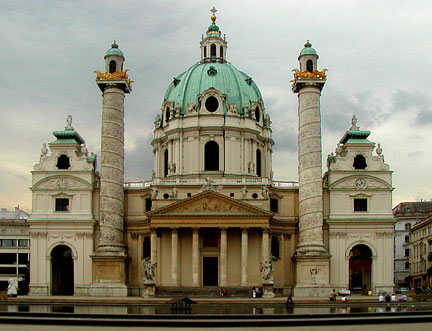 outh of the Opera house (which was under considerable renovation while we were there) is the Karlsplatz, another green park area with play areas for the kids and a small skateboard area (probably to keep them off the marble steps elsewhere). In this platz is the Baroque Karlskirche (right) with its lovely spiral towers.
outh of the Opera house (which was under considerable renovation while we were there) is the Karlsplatz, another green park area with play areas for the kids and a small skateboard area (probably to keep them off the marble steps elsewhere). In this platz is the Baroque Karlskirche (right) with its lovely spiral towers.